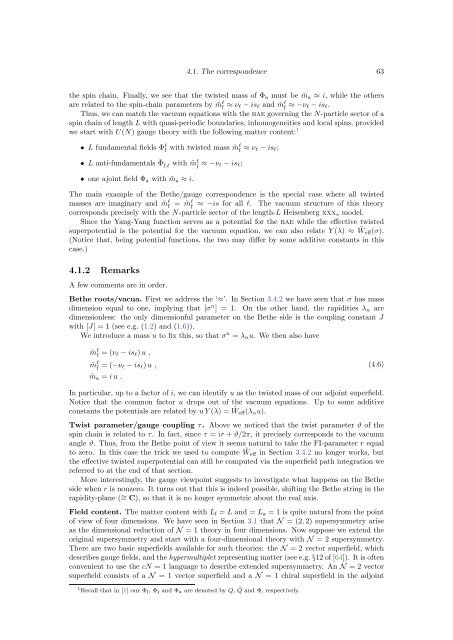The Bethe/Gauge Correspondence
The Bethe/Gauge Correspondence
The Bethe/Gauge Correspondence
Create successful ePaper yourself
Turn your PDF publications into a flip-book with our unique Google optimized e-Paper software.
4.1. <strong>The</strong> correspondence 63the spin chain. Finally, we see that the twisted mass of Φ a must be ˜m a ≈ i, while the othersare related to the spin-chain parameters by ˜m l f ≈ ν l − is l and ˜m l¯f ≈ −ν l − is l .Thus, we can match the vacuum equations with the bae governing the N-particle sector of aspin chain of length L with quasi-periodic boundaries, inhomogeneities and local spins, providedwe start with U(N) gauge theory with the following matter content: 1• L fundamental fields Φ l f with twisted mass ˜ml f ≈ ν l − is l ;• L anti-fundamentals ¯Φ¯f,l with ˜m l¯f ≈ −ν l − is l ;• one ajoint field Φ a with ˜m a ≈ i.<strong>The</strong> main example of the <strong>Bethe</strong>/gauge correspondence is the special case where all twistedmasses are imaginary and ˜m l f= ˜m l¯f ≈ −is for all l. <strong>The</strong> vacuum structure of this theorycorresponds precisely with the N-particle sector of the length-L Heisenberg xxx s model.Since the Yang-Yang function serves as a potential for the bae while the effective twistedsuperpotential is the potential for the vacuum equation, we can also relate Y (λ) ≈ ˜W eff (σ).(Notice that, being potential functions, the two may differ by some additive constants in thiscase.)4.1.2 RemarksA few comments are in order.<strong>Bethe</strong> roots/vacua. First we address the ‘≈’. In Section 3.4.2 we have seen that σ has massdimension equal to one, implying that [σ n ] = 1. On the other hand, the rapidities λ n aredimensionless: the only dimensionful parameter on the <strong>Bethe</strong> side is the coupling constant Jwith [J] = 1 (see e.g. (1.2) and (1.6)).We introduce a mass u to fix this, so that σ n = λ n u. We then also have˜m l f = (ν l − is l ) u ,˜m l¯f = (−ν l − is l ) u ,˜m a = i u .(4.6)In particular, up to a factor of i, we can identify u as the twisted mass of our adjoint superfield.Notice that the common factor u drops out of the vacuum equations. Up to some additiveconstants the potentials are related by u Y (λ) = ˜W eff (λ n u).Twist parameter/gauge coupling τ. Above we noticed that the twist parameter ϑ of thespin chain is related to τ. In fact, since τ = ir + ϑ/2π, it precisely corresponds to the vacuumangle ϑ. Thus, from the <strong>Bethe</strong> point of view it seems natural to take the FI-parameter r equalto zero. In this case the trick we used to compute ˜W eff in Section 3.4.2 no longer works, butthe effective twisted superpotential can still be computed via the superfield path integration wereferred to at the end of that section.More interestingly, the gauge viewpoint suggests to investigate what happens on the <strong>Bethe</strong>side when r is nonzero. It turns out that this is indeed possible, shifting the <strong>Bethe</strong> string in therapidity-plane ( ∼ = C), so that it is no longer symmetric about the real axis.Field content. <strong>The</strong> matter content with L f = L and = L a = 1 is quite natural from the pointof view of four dimensions. We have seen in Section 3.1 that N = (2, 2) supersymmetry ariseas the dimensional reduction of N = 1 theory in four dimensions. Now suppose we extend theoriginal supersymmetry and start with a four-dimensional theory with N = 2 supersymmetry.<strong>The</strong>re are two basic superfields available for such theories: the N = 2 vector superfield, whichdescribes gauge fields, and the hypermultiplet representing matter (see e.g. §12 of [64]). It is oftenconvenient to use the cN = 1 language to describe extended supersymmetry. An N = 2 vectorsuperfield consists of a N = 1 vector superfield and a N = 1 chiral superfield in the adjoint1 Recall that in [1] our Φ f , Φ¯f and Φ a are denoted by Q, ˜Q and Φ, respectively.
















